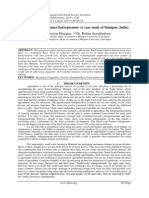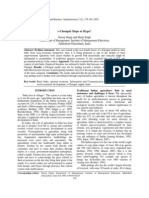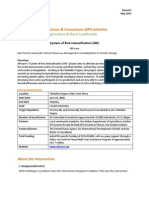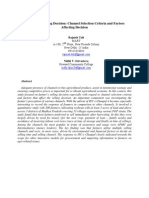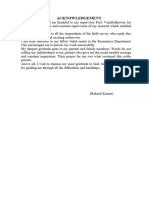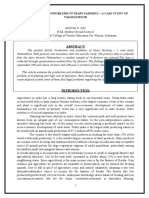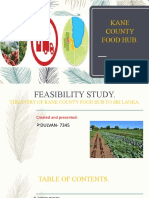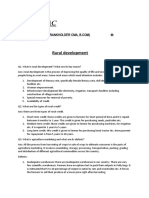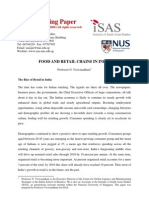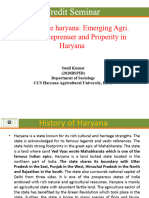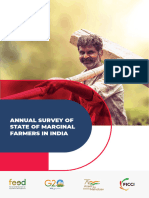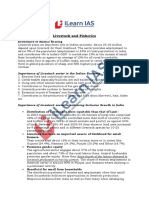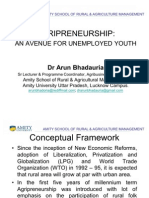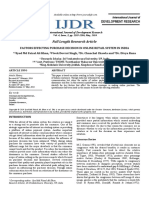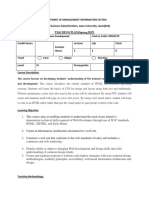Research Article: ISSN: 0975-833X
Research Article: ISSN: 0975-833X
Uploaded by
Syed Faisal AliCopyright:
Available Formats
Research Article: ISSN: 0975-833X
Research Article: ISSN: 0975-833X
Uploaded by
Syed Faisal AliOriginal Title
Copyright
Available Formats
Share this document
Did you find this document useful?
Is this content inappropriate?
Copyright:
Available Formats
Research Article: ISSN: 0975-833X
Research Article: ISSN: 0975-833X
Uploaded by
Syed Faisal AliCopyright:
Available Formats
z
Available online at http://www.journalcra.com
INTERNATIONAL JOURNAL
OF CURRENT RESEARCH
International Journal of Current Research
Vol. 6, Issue, 02, pp.5150-5153, February, 2014
ISSN: 0975-833X
RESEARCH ARTICLE
BASIL (Tulsi) PRODUCTION IS AN INCOME GENERATING ACTIVITY FOR POOR AND MARGINAL
FARMERS IN INDIA
1Vinay
Gunwant, 2Manoj Rawat, 3Purohit, R. C., 4Pankaj Dhaundiyal and
*5Syed Md. Faisal Ali Khan
1Department
of Commerce, MBPG College Haldwani, Kumaon University, Nainital, Uttarakhand, India
2Department of Management, Sikkim Manipal University, Manipal, India
3Associate Prof., Department of Commerce, MBPG College Haldwani, Kumaon University,
Uttarakhand India
4 Ph.D., Research Scholar, Dept. of Commerce, MBPG College Haldwani, Kumaon University, Uttarakhand,
India
5 Lecturer and Coordinator Quality Assurance and Control Unit, Department of MIS, College of Business
Administration, Jazan University, Kingdom of Saudi Arabia and
Under the Guidance of: Dr. Divya Rana, Asst. Prof., FEA, King Abdul Aziz University, Kingdom of Saudi Arabia
ARTICLE INFO
ABSTRACT
Article History:
Basil, the "Royal Herb" in India is popularly known as Tulsi. Tulsi has been described as early as the
vedic period. Tulsi is the most sacred and holy plant of India dedicated to Hindu culture and Hindu
ceremonies. Its leaves are used in the worship of gods, goddesses and partaken as Prasad (Holy food).
Chamoli is one of the backward hilly districts of Uttarakhand State. Although women in this area play
a very significant role in subsistence economy, their contribution to socio-economic development is
not recognized yet. Over 70% of the total population mostly women are engaged in traditional
agricultural activities. Most of the agriculture in the region is rain fed with a very low productivity of
the food crops. The farmers / producers in the region are poor and marginal and are totally dependent
on agriculture for their livelihood. Apart from the low productivity the farmers are facing a severe
problem of wild animals (wild boar and monkey) damaging their crop and further reducing the food
production and the ultimate annual income.
Received 04th November, 2013
Received in revised form
10th December, 2013
Accepted 26th January, 2014
Published online 21st February, 2014
Key words:
SC=Schedule Class,
SC=Schedule Tribe,
OBC= Other Backward Class,
GOI= Government of India
Copyright 2014 Vinay Gunwant et al. This is an open access article distributed under the Creative Commons Attribution License, which permits unrestricted
use, distribution, and reproduction in any medium, provided the original work is properly cited.
INTRODUCTION
Tulsi (basil) plants are increasingly being recognized as an
important source of significant livelihood opportunities for
rural poor and a source of revenue for Government also. The
collection and cultivation of Tulsi (basil) provides an important
source of cash income to many rural communities specially
women, primitive forest dependent tribes, poor and
marginalized farmers. According to Government of Indias
Statistics, the collection and processing of medicinal and
aromatic plants contribute to at least 35 Million working days
of employment in a year (GOI 2000). The global demand of
medicinal plants has been estimated at 60 to 62 billion US $
which is increasing at a rate of 7 -10 % annually. The project
Enhancing livelihood of the poor and marginal farmers
through pro-poor value chain development of Tulsi (basil) is
*Corresponding author: Syed Md. Faisal Ali Khan,
Department of MIS, College of Business Administration, Jazan University,
Kingdom of Saudi Arabia.
been carried with an objective to assure better economic
security to the small, marginal and poor farmers by providing
technologies throughout the value chain of Tulsi (basil); from
procurement to the market development of the value added
products. The project is financial assisted by ICIMOD and
implemented in Ghat and Kaleshwar area in district Chamoli of
Uttarakhand. HARC as a facilitator worked with 200 targeted
families, which are engaged in Tulsi cultivation. The
cooperative working in processing with the SHGs at CFC
mainly women members are in achieving increased income by
production and sale of high value products from Tulsi (Basil).
Objective of the study
The Primary object of the base line study is to identify what
ails in this region, few are detailed below:1. To evaluate the current status of the producing crops in
identified this region in terms of the productivity and
availability, the number of farmers and size of the farm
5151
Vinay Gunwant et al. Basil (tulsi) production is an income generating activity for poor and marginal farmers in India
land (irrigated, un-irrigated or barren land). Status of the
farmers and agricultural activities in which they are
engaged as well as role of support organization (if any) and
prevailing infrastructure facilities.
2. The socio-economic technical, non- technical knowhow
environmental, ecological and cultural, educational
development of the region.
3. Income Generating and self employment generating
program through adopting new method of agricultural
practices, skill development and value addition techniques
through local resources available.
household around 75% (i.e. 38% and 37%) are engaged in
farming and household activities and rest of them are 10%, 5%
and 6% are in wage labor, petty business, shop keeping and
just 4% are studying. The literacy level is low among women
than men in the families. As far as young generation is
concerned almost all children are attending the school.
To fulfill the above objectives the primary base line survey in
these villages has conducted for understanding of this region, is
based on analyzing the value chain that exist in the cluster. It
includes the farmers, producing traditionally growing crops,
major cash crops, production, market and the role of the
institution/ organizations. The support institutions are the
government bodies and social organization.
MATERIALS AND METHODS
The research is conducted at the grawehal region of
Uttarakhand. In order to get the information about the
availability, varieties, production and marketing opportunities
etc., the primarily data was collected through household
survey. In the first stage Chamoli district of Garhwal region
was selected purposively based on the importance and
contribution in terms of area and production of Basil in
Uttarakhand. The study was conducted in 05 villages of three
development block i.e. Karanpryag, Pokhari and Ghaat in
Chamoli district as it had the highest area under Basil
production. A sample size of around 100 growers was selected
randomly. 05 village level meeting were organized during the
survey, it was kept in mind that household from all socio
economic classes of the society are presented.
Fig. 1. Total population in the sample
Land ownership and type (in Nali)
Land is the most valued productive resources which is wealth
creating and livelihood sustaining assets for a significant
Table 1. Basil Producing Areas and Sample Collected.
S.No.
1.
2.
3.
4.
5.
Name of the Village
Sainti
Faali
Chamali
Langashu
Jilashu
Total
Development Block
Ghaat
Ghaat
Karanpryag
Karanpryag
Pokhari
Nos. of HH (SC/ST/OBC)
07
10
00
00
00
17
The outcome of the study
The study was conducted in 05 villages in three development
block i.e. Karanpryag, Pokhari and Ghaat in Chamoli district of
Uttarakhand state. The survey covered 100 households include
those, who are marginal farmers and are just above or below
poverty line.
Nos. of HH (General)
13
10
20
20
20
83
M
36
42
48
72
57
225
F
32
34
36
66
51
219
Interview with HH
20
20
20
20
20
100
majority of the interview household. The size of land holding
and its productivity determine the social and economic status
of a farming family. (50 Nali =1 Ha).
Socio economic profile
The socio- economic profile reveals the social status and
economic condition of the household families. Assessing the
socio-economic profile of the household is crucial for
prioritizing the needs of the stakeholder which is linked with
the successes of any developmental programme. Most of the
Fig. 2. Land holding scattered
5152
International Journal of Current Research, Vol. 6, Issue, 02, pp.5150-5153, February, 2014
Agricultural land are scattered in the region and divided into 4
types. The analysis of data regarding the land holding reveals
that the average size of land holding per family is less than one
hectare. As per the following 33% land are divided in two
pieces, 27% in four, 24% in 6 and 16% in more than eight
pieces. When, we ask about the time take to reach each of the
cluster plots household takes minimum 20 minutes and
maximum 1 hour to reach their field.
Traditional Crop Production
The data reveals that most of the farmers are still producing
traditional crops and very few farmers having annual family
income Rs. 10000 to Rs.100000.
how can increase the productivity. It is highly concerned with
use of barren land and productivity and market. 19% household
says that it is very difficult for them to approach banks and
apply for the loan.
Taken up new high value crop
As per the data reveal that 65 of 100 household are taking their
interest to producing new high value crops specially in tulsi
cultivation. We ask who decides which crops to produce to the
household, 60% from them answered women. It was obvious;
women in this region play a very significant role in subsistence
economy. Though women are engaged in agriculture activities
but when the time comes for marketing the produce, it is the
man who handles all the monetary matters and transaction.
Fig. 3. Production Pattern
Cash Crops Production
In agrarian society agriculture and livestock rearing is the main
source of income. So earning from these sources is always a
family income. Now more than 65 household out of 100
interviewed are engaged in fruit, vegetable and basil
cultivation. The cooperative is also engaged in marketing of
spices, fruits and tulsi. The member sells their produce to the
cooperative especially in fruits and tulsi. The cooperative fixes
a rate for these produce, which is much better than the rate
given by the middlemen, and buy it from the member on cash
basis. Farmers are showing more intrest in tulsi cultivation. It is
very clear through the observation and interaction with the
household that from tulsi, the HH are getting better
productivity as well as higher prices for their crops in less time
and without damaging their crop by the wild animals.
Fig. 5. Preference of Production
When we ask to them why are they cultivating new crops?
Approximately 90% of them are agreed with each other and
their answer was yes reason was pay back guarantee from the
local cooperative are available so market is close to the
producing villages and cooperative is providing technical
knowhow, input services as well as better prices for their
produce.
Fig. 6. Total return from the cultivation
Conclusion and policy implications
Fig. 4. Hindering Factors
Constraints in crop production
As per the data reveals that, most of the household about 21%
says irrigation is the most constraint for them, without that
The present study has clearly found that marketing problems of
hilly areas is different from other regions of the country.
Scattered farms, poor irrigation, finance, animal attack and
high input cost, therefore, producers are reluctant to bring their
5153
Vinay Gunwant et al. Basil (tulsi) production is an income generating activity for poor and marginal farmers in India
produce themselves in the market. Although the cooperatives
are working in the village level but government have to play
the crucial role for basil production and its marketing
strengthen. Create pressure group to channelize the total
government budget to rural irrigation arrangement.
Government Market regulatory authorities should provide loan
to the farmers in a low interest rate (Low interest for
agriculture and herbs). This would be an attraction for poor
farmers and provide confidence and encourage cultivating the
basil crops.
REFERENCES
Anthwal et al. 2006. Sacred Groves: Traditional Way of
Conserving Plant Diversity in Garhwal Himalaya,
Uttarakhand
Dabral, S. P. 2000. Uttarakhand Ka Itihas. (in Hindi), Garhwal
publishing house, Doggada Kotdwar, Uttaranchal.
Government of Indias Statistics, 2000.
Kareemulla, K.; Tewari, R.K.; Singh, B. and Kumar, K. 2007.
Production and marketing of Indian gooseberry- aonla
(Emblica officinalis) in Pratapgarh district of Uttar
Pradesh. Indian Journal of Agricultural Marketing.
21(2): 41.
Randev, A.K. 2005. Marketing of Apple in Shimla district of
Himachal Pradesh- India. Indian Journal of Agriculture
Marketing. 19(3): 13-16.
Saraswat, S.P.; Dahiya, P.S. and Singh, P. 2006. Production
and marketing of peach f fruit: a case study of Rajgarh area
of district Sirmour in Himachal Pradesh. Indian Journal of
Agricultural Marketing. 20(2): 87-88.
Sati, Vishwambhar Prasad. 2004. Resource Utilization Pattern
and Development in Hills: A Case for the Pindar Basin of
Garhwal Himalaya. Journal for Mountain Science Vol 1,
No. 2, pp 130-141 www.imde.ac.cn/journal.
Sati, Vishwambhar Prasad. 2005. Natural Resource Conditions
and Economic Development in the Uttaranchal Himalaya,
India. Journal of Mountain Science, Vol 2, No 4, 336-350
www.imde.ac.cn/journal.
*******
You might also like
- Abm 5221Document57 pagesAbm 5221davidmarkam14No ratings yet
- Enterprising The Farmer Entrepreneur (A Case Study of Manipur, India)Document7 pagesEnterprising The Farmer Entrepreneur (A Case Study of Manipur, India)inventionjournalsNo ratings yet
- Ven FinrepoDocument78 pagesVen FinrepoNikhil MehareNo ratings yet
- PDF/ajebasp 2010 179 184Document6 pagesPDF/ajebasp 2010 179 184tarcher1987No ratings yet
- S1R1 201703101710013Document39 pagesS1R1 201703101710013A-06 VRUNDA BHINGARADIYANo ratings yet
- BPI Round 3 - Africare - UpdatedDocument11 pagesBPI Round 3 - Africare - UpdatedInterActionNo ratings yet
- Farmer's Selling Decision: Channel Selection Criteria and Factors Affecting DecisionDocument9 pagesFarmer's Selling Decision: Channel Selection Criteria and Factors Affecting DecisionShovit SinghNo ratings yet
- Abe PaperDocument15 pagesAbe PaperRod MondoyoNo ratings yet
- ACKNOWLEDGEMENTDocument6 pagesACKNOWLEDGEMENTGirish SalunkheNo ratings yet
- Rural DevelopmentDocument21 pagesRural Developmentdeepti GuptaNo ratings yet
- Ya 1Document18 pagesYa 1krishnatradingcompany udtNo ratings yet
- Rural Development NotesDocument5 pagesRural Development NotesHarsha AmlaniNo ratings yet
- A Study On Development Trends of Food Processing Sector in India - Dr. Anoop Kumar Singh Vol-5-Issue-1Document7 pagesA Study On Development Trends of Food Processing Sector in India - Dr. Anoop Kumar Singh Vol-5-Issue-1Sravya DoppaniNo ratings yet
- Project ON: Government Policy and Performance of Indian AgricultureDocument20 pagesProject ON: Government Policy and Performance of Indian AgricultureAnonymous LudPlljf57No ratings yet
- Agricultural Productivity in IndiaDocument62 pagesAgricultural Productivity in IndiaKamal SinghNo ratings yet
- Research Note-Romaza Khanum - Impact of Enterprenurship-1Document14 pagesResearch Note-Romaza Khanum - Impact of Enterprenurship-1Navinkumar RohitNo ratings yet
- 09 - Chapter 1 PDFDocument11 pages09 - Chapter 1 PDFVishalchettriNo ratings yet
- Production and Problems of Diary Farming - A Case Study of VadavathoorDocument7 pagesProduction and Problems of Diary Farming - A Case Study of VadavathoorSruthi k. JoyNo ratings yet
- Kane County Food Hub (Feasibility Report)Document35 pagesKane County Food Hub (Feasibility Report)Dulvan Devnaka Senaratne100% (2)
- Malilo-Task 1Document4 pagesMalilo-Task 1Charlz CacaNo ratings yet
- Brians Project Proposols PresentationDocument48 pagesBrians Project Proposols PresentationBigman VinnieNo ratings yet
- Baseline and Situation Analysis Report IDocument47 pagesBaseline and Situation Analysis Report IDiesel PowerNo ratings yet
- Final SynopsisDocument22 pagesFinal Synopsisdeepthi nNo ratings yet
- Area Development Scheme Dairy Development in Vellore DistrictDocument16 pagesArea Development Scheme Dairy Development in Vellore DistrictNaveen KumarNo ratings yet
- Article 4Document19 pagesArticle 4Harsha BangarNo ratings yet
- RuralDocument8 pagesRuralRohan SinghNo ratings yet
- Agricultural DevelopmentDocument14 pagesAgricultural DevelopmentSyeda Tooba KazmiNo ratings yet
- Revath economicsDocument21 pagesRevath economicsAdithyan NairNo ratings yet
- Rural DevelopmentDocument40 pagesRural DevelopmentrobockxxNo ratings yet
- Agri Manipur 1 ST IssueDocument18 pagesAgri Manipur 1 ST IssueDayanidhi HuidromNo ratings yet
- Agricultural Economics Thesis Topics in IndiaDocument4 pagesAgricultural Economics Thesis Topics in IndiaMaria Perkins100% (2)
- Synopsis Dr. B.R. Ambedkar University, Agra Doctor of PhilosophyDocument19 pagesSynopsis Dr. B.R. Ambedkar University, Agra Doctor of PhilosophyMordhwaj Singh TomarNo ratings yet
- ISAS Working Paper: Food and Retail Chains in IndiaDocument34 pagesISAS Working Paper: Food and Retail Chains in India30022No ratings yet
- Rift Valley University Chiro Compus: School of Graduate StudiesDocument38 pagesRift Valley University Chiro Compus: School of Graduate StudiesBobasa S AhmedNo ratings yet
- Understanding Agribusiness ManagementDocument11 pagesUnderstanding Agribusiness ManagementFerguson WankharNo ratings yet
- Supply Chain Management of Perishable GoodsDocument20 pagesSupply Chain Management of Perishable GoodskakadeaashishNo ratings yet
- A Handbook of BeekeepingDocument22 pagesA Handbook of BeekeepingAswini sreenarayanaNo ratings yet
- Livestock Interventions For Improving The Livelihood in Hilly Eco-System of UttarakhandDocument10 pagesLivestock Interventions For Improving The Livelihood in Hilly Eco-System of UttarakhandTJPRC PublicationsNo ratings yet
- Food Processing Sector in India On Growth Path: by Saloni NangiaDocument2 pagesFood Processing Sector in India On Growth Path: by Saloni NangiaZa IdNo ratings yet
- Smallholder Farmers Participation in Livestock Markets: The Case of Zambian FarmersDocument38 pagesSmallholder Farmers Participation in Livestock Markets: The Case of Zambian FarmersJosephine ChirwaNo ratings yet
- HAWASSA UNIVERSITY sura (4)Document23 pagesHAWASSA UNIVERSITY sura (4)kebedeababe336No ratings yet
- Rural Industry: InnovationsDocument11 pagesRural Industry: Innovationssiva nagendraNo ratings yet
- 17 - Summary and ConclusionsDocument32 pages17 - Summary and ConclusionsKrishna KumarNo ratings yet
- JETIR1904C23Document5 pagesJETIR1904C23Priyankita PreetNo ratings yet
- Why Cultivation of Azolla As A Cattle Feed Not SustainableDocument7 pagesWhy Cultivation of Azolla As A Cattle Feed Not SustainableTarigNo ratings yet
- Emerging Agri Tech Entrepreneur and Properity in HaryanaDocument53 pagesEmerging Agri Tech Entrepreneur and Properity in Haryanabishnoi40008No ratings yet
- Annual Survey For Marginal FarmersDocument40 pagesAnnual Survey For Marginal Farmerskumarg197328No ratings yet
- Account AssignmentDocument20 pagesAccount Assignmentsachingulabal08No ratings yet
- A_Study_on_Recent_Issues_of_Agro-Based_Industry_in (1)Document5 pagesA_Study_on_Recent_Issues_of_Agro-Based_Industry_in (1)afreenmehatajNo ratings yet
- Livestock and Fisheries: Economics of Animal RearingDocument7 pagesLivestock and Fisheries: Economics of Animal RearingBASELALNo ratings yet
- Local Coop in PhilDocument15 pagesLocal Coop in Philcris lu salemNo ratings yet
- A Report On Improving Agriculture Performance Subject: Seminar On ContemporaryDocument26 pagesA Report On Improving Agriculture Performance Subject: Seminar On ContemporaryVeeral Shah100% (1)
- ShamsuddohaDocument27 pagesShamsuddohamahfujmir3No ratings yet
- Chapter - One Research Design and MethodologyDocument31 pagesChapter - One Research Design and Methodologypmp aspirantNo ratings yet
- Metro Dairy Farming in BangladeshDocument9 pagesMetro Dairy Farming in BangladeshNiloy RahmanNo ratings yet
- AgripreneurshipDocument36 pagesAgripreneurshipArun Kumar Bhadauria100% (2)
- Analysis of AgriDocument37 pagesAnalysis of AgriNitish JoshiNo ratings yet
- Agriculture in India: Contemporary Challenges: in the Context of Doubling Farmer’s IncomeFrom EverandAgriculture in India: Contemporary Challenges: in the Context of Doubling Farmer’s IncomeNo ratings yet
- Economic Opportunity Small Scale Dairy Farms at Keren Sub Zone of EritreaFrom EverandEconomic Opportunity Small Scale Dairy Farms at Keren Sub Zone of EritreaNo ratings yet
- Agriculture Interview Questions and Answers: The Complete Agricultural HandbookFrom EverandAgriculture Interview Questions and Answers: The Complete Agricultural HandbookRating: 4 out of 5 stars4/5 (1)
- Proximity MarketingDocument13 pagesProximity MarketingSyed Faisal AliNo ratings yet
- Assesing Government Intervention Towards The Development of Entrepreneurship in Saudi ArabiaDocument2 pagesAssesing Government Intervention Towards The Development of Entrepreneurship in Saudi ArabiaSyed Faisal AliNo ratings yet
- Influencing Factors For Online Purchase - A Case Study of Delhi and NCR Region of IndiaDocument7 pagesInfluencing Factors For Online Purchase - A Case Study of Delhi and NCR Region of IndiaSyed Faisal AliNo ratings yet
- Tourist Satisfaction IndexDocument19 pagesTourist Satisfaction IndexSyed Faisal AliNo ratings yet
- Ijaiem 2016 05 08 8 PDFDocument6 pagesIjaiem 2016 05 08 8 PDFSyed Faisal AliNo ratings yet
- Full Length Research Article: Issn: 2230-9926Document4 pagesFull Length Research Article: Issn: 2230-9926Syed Faisal AliNo ratings yet
- TourismDocument10 pagesTourismSyed Faisal AliNo ratings yet
- Eija C It 120071Document10 pagesEija C It 120071Syed Faisal AliNo ratings yet
- Course Name: Course Code: MGIS372 Credit Hours Contact Hours Lab Total 2 2 4 Track Core Major Elective Level IV PrerequisiteDocument6 pagesCourse Name: Course Code: MGIS372 Credit Hours Contact Hours Lab Total 2 2 4 Track Core Major Elective Level IV PrerequisiteSyed Faisal AliNo ratings yet
- Chapter 1: IntroductionDocument63 pagesChapter 1: IntroductionSyed Faisal AliNo ratings yet

